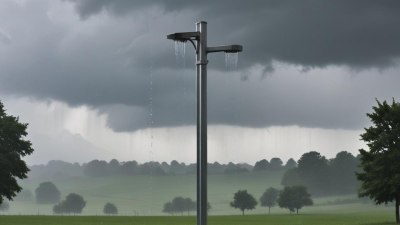What the Weather App Gets Wrong About Your Work Rhythm
Explore how weather apps misinterpret your work rhythm and why understanding this gap can boost productivity.

Image created with Flux Schnell
Weather apps have become an integral part of our daily routines, offering timely updates to help us plan everything from our morning commute to weekend outings. But while these applications excel at providing meteorological data, they often miss a crucial aspect of our lives—the intricate relationship between weather and our personal work rhythms.
At first glance, the connection between weather and work productivity may seem straightforward. After all, a gloomy sky or sudden rainstorm can put a damper on your schedule, while a sunny day might boost your mood and energy levels. Yet, the reality is far more complex, and weather apps frequently overlook the nuances that influence how people work throughout the day.
This article dives into the common misconceptions that weather applications have about our work rhythms, explores scientific evidence on how weather actually affects productivity, and offers insights into what a truly work-aware weather app might look like.
The Simplistic Link Between Weather and Productivity
Most weather apps provide users with a straightforward set of data: temperature, precipitation, humidity, and wind conditions. These metrics are essential for planning outdoor activities, but they rarely translate these factors into personalized suggestions related to work habits or productivity patterns.
Users are often left to interpret the data on their own, assuming that, for example, a bright sunny day equates to more energy and focus, or that rain might be a cue to slow down or take breaks. While these generalizations hold some intuitive appeal, psychological and physiological responses to weather are highly individual and influenced by a host of additional factors including chronotype, mental health, and job requirements.
Therefore, the assumption that weather directly correlates with one's ability to work neglects the complex interplay of environmental conditions and human biology.
Chronotypes and Their Influence on Work Rhythms
One crucial aspect that weather apps miss is the role of chronotypes in determining when a person is naturally more productive. Chronotypes refer to the patterns of circadian rhythms that influence whether someone is a morning person (lark), an evening person (owl), or somewhere in between.
For instance, a morning-type individual might find their productivity peaks early in the day, regardless of weather conditions, while an evening-type may thrive later. Weather can modulate mood and energy, but it cannot override the ingrained biological clock that dictates these rhythms.
Additionally, weather elements like sunlight exposure influence circadian rhythms through melatonin regulation. Insufficient daylight during winter months can lead to Seasonal Affective Disorder (SAD), affecting energy and motivation. However, an app that simply reports low sunlight without considering the user's chronotype or specific work schedule offers limited actionable insight.
Mood, Motivation, and Weather: A Complex Cocktail
There is no doubt that weather impacts mood, which in turn influences work rhythms. For example, bright sunshine often correlates with elevated serotonin levels and improved mood, potentially heightening motivation and focus. Conversely, gloomy or overcast weather can induce feelings of lethargy or sadness.
However, responses to weather cues are not uniform. Some people genuinely enjoy working during rainy or cloudy weather, finding it calming or conducive to creativity. Others may find even a slight drizzle frustrating. These differences highlight the inadequacies of a one-size-fits-all approach used by weather apps to predict productivity or suggest optimal work times.
Furthermore, mood is influenced by many other variables including sleep quality, physical health, work environment, and personal stress levels. Weather conditions represent just one thread in the broader psychological tapestry affecting work rhythms.
Environmental Comfort Versus Actual Work Performance
Weather apps often emphasize comfort—whether it is too hot, too cold, too humid, or too windy. While these factors certainly impact physical comfort and can affect willingness to engage in work tasks, especially in non-climate-controlled environments, they do not paint a full picture of work performance.
For many office workers, indoor climate control mitigates external weather effects substantially, disconnecting weather reports from actual work conditions. Yet, many apps do not differentiate between indoor and outdoor workers when providing their forecasts or recommendations.
In contrast, field workers, construction staff, or service industry professionals might experience direct and immediate effects from weather variations that influence their schedules and productivity. Even so, weather apps rarely tailor their information or advice based on the user’s occupational context, thus missing an opportunity to better support diverse work conditions.
The Temporal Complexity of Work Rhythms
Work rhythms are not static throughout the day or week; they fluctuate. Many people experience biphasic or polyphasic patterns of alertness—for example, heightened focus mid-morning, a post-lunch dip, and a second wind later in the afternoon. Weather impacts these cycles differently depending on time of day.
A sudden storm during the morning might disrupt headspace and concentration, whereas the same storm in the late afternoon might coincide with natural winding down periods of productivity. Weather apps rarely contextualize hourly forecasts in this way, ignoring the temporal fluidity of work rhythms.
Moreover, multi-day weather patterns such as prolonged rainy spells or heat waves have compounded effects on motivation and fatigue levels, further complicating how weather truly interfaces with work rhythms. Unfortunately, this complexity is beyond the scope of typical weather apps, which prioritize immediate, surface-level data.
The Illusion of Predictive Power
Some modern weather apps attempt to integrate AI or machine learning to predict optimal outdoor times or suggest the best days for activities. Yet, when it comes to work rhythm predictions, this technology falls short.
Why? Because machine learning models require robust datasets combining weather variables with personal productivity metrics—data that is both complex and privacy-sensitive. Without individualized input, predictions become generic and often misleading.
For example, an app might suggest “great weather for productivity” on a breezy sunny day without knowing that the user is dealing with a critical project deadline, recent burnout, or family stress, all of which can overshadow weather’s influence.
Personalization: The Next Frontier
To better align weather information with work rhythms, future apps must embrace personalization. This would involve collecting user-specific data such as chronotype, typical work schedule, preferred work environment, and even mood tracking.
Imagine an app that integrates your calendar, sleep patterns, and task priorities with real-time weather conditions to suggest when you should tackle demanding cognitive work versus when to focus on administrative tasks or take restorative breaks. Such an approach could help optimize both work efficiency and well-being.
Additionally, apps could offer actionable advice such as adjusting lighting to mimic natural daylight on gloomy days, recommending outdoor breaks during optimal weather, or alerting users to potential mood shifts based on meteorological patterns combined with personal data.
Technology Meets Biology and Psychology
Achieving this level of sophistication in weather apps demands collaboration across disciplines—meteorologists, chronobiologists, psychologists, and software developers all have roles to play.
Technological advancements in wearable sensors that monitor physiological signals like heart rate variability, skin temperature, and movement could provide valuable context to interpret how weather influences individual work rhythms. Meanwhile, psychological assessments could refine how mood and motivation are factored into app algorithms.
Integrating these insights would transform weather apps from mere forecasting tools into intelligent assistants for personal productivity management.
Barriers to Adoption and Privacy Concerns
Despite potential benefits, there are barriers to this vision becoming reality. Collecting detailed personal and physiological data raises concerns about privacy and data security that cannot be overlooked.
Users may be hesitant to share intimate details about their mood, health, or work habits. Developers must ensure transparency in data usage, robust encryption, and clear opt-in mechanisms to build trust.
Furthermore, the complexity of creating accurate, individualized models introduces risks of misinterpretation or overgeneralization, which could lead to frustration rather than improved productivity.
Practical Tips for Working With Weather Realities
While waiting for smarter weather apps, individuals can apply some practical strategies to harmonize weather conditions with their work rhythms.
First, maintain awareness of your personal chronotype and try to schedule challenging tasks during naturally high-energy periods. Use weather forecasts as a supplementary guide rather than a sole determinant.
Second, adjust your physical environment to counteract negative weather effects: improve indoor lighting on dark days, use fans or heaters as needed, and create comfortable workspaces to minimize external discomfort.
Third, allow flexibility in your daily schedule to accommodate mood fluctuations tied to weather changes. Taking short breaks, practicing mindfulness, or engaging in light physical activity can help maintain focus and resilience.
Reframing the Relationship Between Weather and Work
Ultimately, the interaction between weather and work rhythms is dynamic, multi-dimensional, and deeply personalized. Weather apps that treat environmental indicators as direct predictors of productivity miss the subtle, intricate ways our bodies and minds respond to these factors.
Recognizing this complexity not only helps users avoid simplistic assumptions but also encourages the development of more nuanced tools that respect individual differences and contextual variables.
As technology evolves, so too will the potential to merge environmental science with personal biology and psychology to craft genuinely supportive productivity tools. Until then, maintaining a mindful and flexible approach to daily work routines in connection with weather remains the best strategy.











